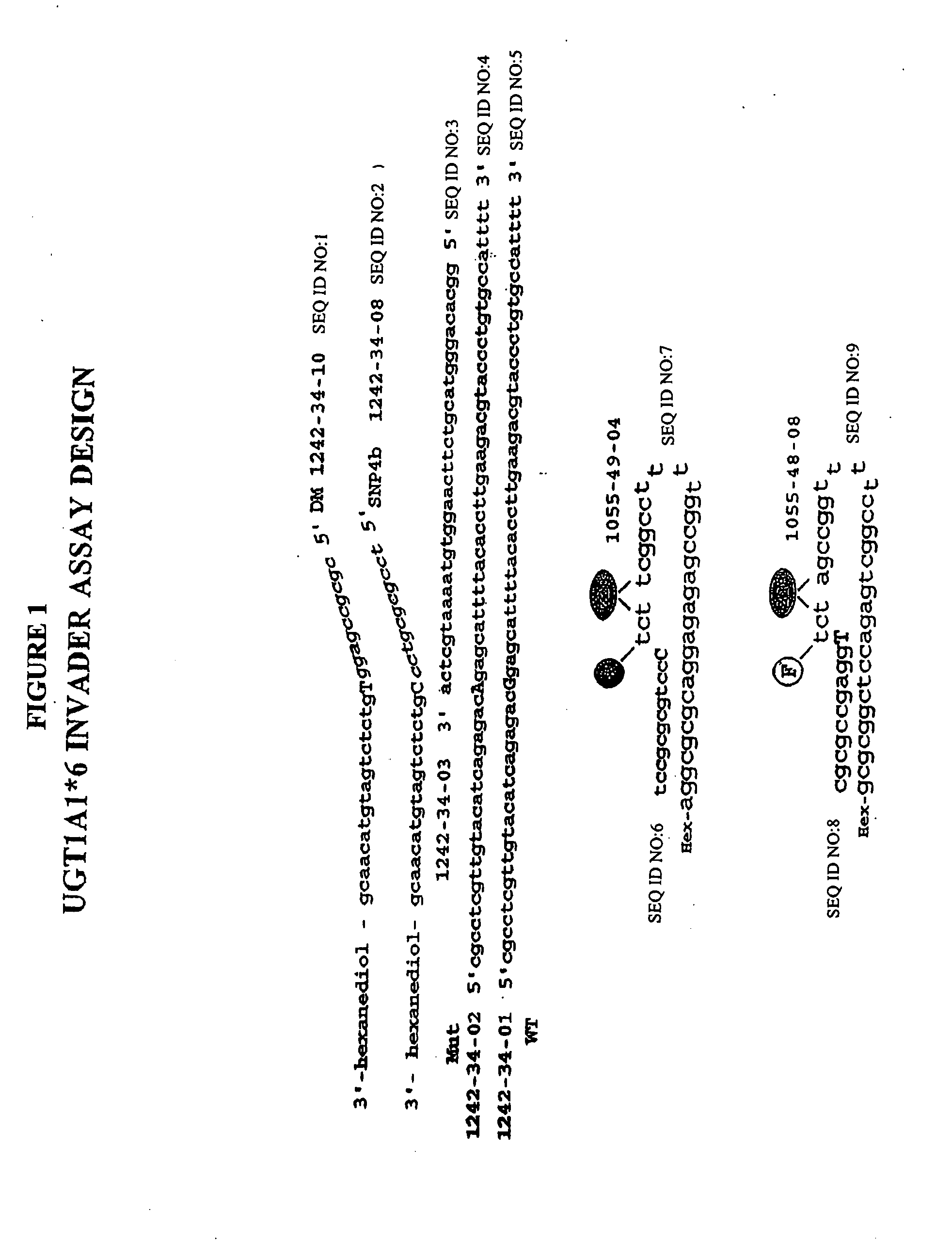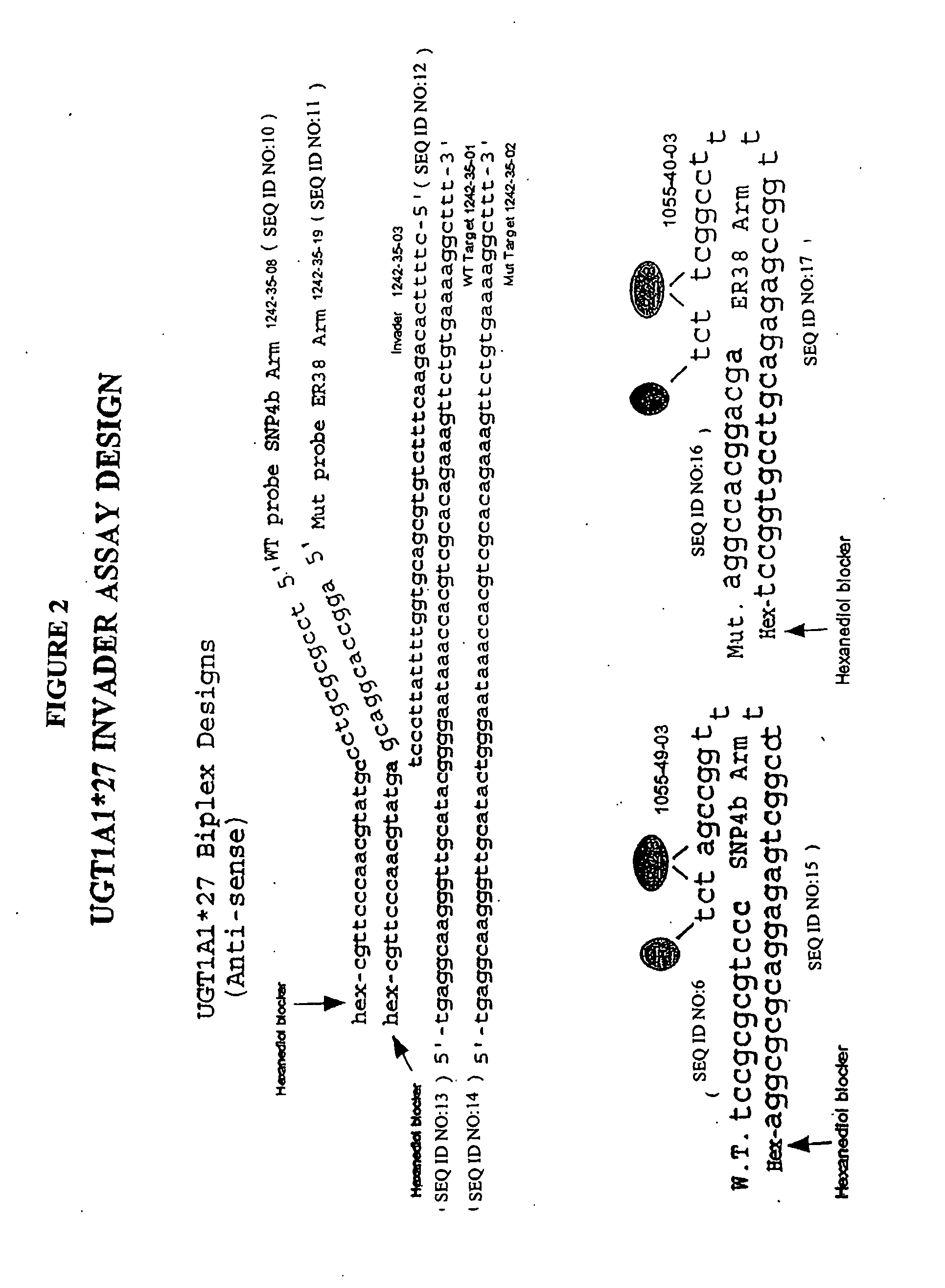Methods and compositions for analysis of UGT1A1 alleles
a technology of alleles and compositions, applied in the field of methods and compositions for analysis of ugt1a1 alleles, can solve the problems of inability to obtain and validate information on the frequency and clinical relevance of many polymorphisms and other variations, failure of probes generated based on reference sequences, and failure of attempts to analyze individuals based on genome sequence information, etc., to avoid problems such as toxicity or lack of efficacy, and facilitate drug therapy
- Summary
- Abstract
- Description
- Claims
- Application Information
AI Technical Summary
Benefits of technology
Problems solved by technology
Method used
Image
Examples
example 1
Reaction set-up:
[0204] Place 10 ul of sample or control in reaction well.
[0205] Overlay with 20 ul Mineral Oil.
[0206] Heat to 95 C for 5 minutes to denature.
[0207] Cool to 63 C for Reaction Mix addition.
[0208] Add 10 ul INVADER Reaction Mix (see below) to each well and mix (e.g., by pipetting).
[0209] Incubate at 63 C for 4 hours.
[0210] Cool to 4 C to await fluorescence reading.
[0211] Warm to room temperature.
[0212] Scan in fluorescence plate reader.
INVADER Reaction Mix (Per Reaction):
[0213] 5 ul DNA Reaction Buffer 1 (14% PEG, 10 mM MOPS pH 7.5, 56 mM MgCl2, 0.02% ProClin 300)
[0214] 1 ul 1 uM Invader Oligo (in Te)
[0215] 1 ul 10 uM each WT and Mut Probes (in Te)
[0216] 1 ul 5 uM Fam FRET (in Te)
[0217] 1 ul 5 uM Red FRET (in Te)
[0218] 1 ul 40 ng / ul Cleavase X (in Cleavase Dilution Buffer)
Final reaction concentrations:
[0219] 3.5% PEG
[0220] 10 mM MOPs
[0221] 1.0 pmol INVADER oligonucleotide
[0222] 10 pmol each primary probe
[0223] 5 pmol each FRET
[0224] 40 ng Cleav...
example 2
TA5 and TA8 INVADER Assays
[0229] The example describes performing TA5 and TA8 UGT1A1 detection with the INVADER assay. The INVADER assay design for TA5 in this example is shown in FIG. 11 and the INVADER assay design for TA8 in this example is shown in FIG. 14. The TA5 and TA8 monoplex assays were run across the same set of genomic samples and synthetic targets. In both cases, the probes reported to Fam dye. The following assay conditions were employed:
ASR 10:10 Reaction Format:
[0230] Place 10 ul of sample or control in reaction well.
[0231] Overlay with 20 ul Mineral Oil.
[0232] Heat to 95 C for 5 minutes to denature.
[0233] Cool to 63 C for Reaction Mix addition.
[0234] Add 10 ul Invader Reaction Mix (see below) to each well; mix by pipetting.
[0235] Incubate at 63 C for 4 hours.
[0236] Cool to 4 C to await fluorescence reading.
[0237] Warm to room temperature.
[0238] Scan in fluorescence plate reader
Invader Reaction Mix (Per Reaction):
[0239] 5 ul DNA Reaction Buffer 1 (14...
example 3
UGT Example 3
UGT1A1*28 Biplexed with Internal Control This example describes one embodiment for a UGT1A1*28 Assay with an Internal Control. The assay may be designed as a 4 well assay in which each *28 probe (TA5, TA6, TA7, and TA8) are biplexed with an internal control. This assay may employ the INVADER assay for one or more of the *28 probes. FIG. 10 shows useful INVADER assay configurations for TA5, TA6, TA7 and TA8, that may be biplexed with the Alpha Actin internal control shown in FIG. 15. Other useful INVADER configurations that may be employed are shown in FIG. 11 (TA5), FIG. 12 (TA6), FIG. 13 (TA7), and FIG. 14 (TA8), which may be biplexed with the internal control shown in FIG. 15.
[0279] Assay set up conditions that may be employed to set up this 4 well assay are as follows.
ASR 10:10 Reaction Format:
[0280] Place 10 ul of sample or control in reaction well. [0281] Overlay with 20 ul Mineral Oil. [0282] Heat to 95 C for 5 minutes to denature. [0283] Cool to 63 C for Reac...
PUM
 Login to View More
Login to View More Abstract
Description
Claims
Application Information
 Login to View More
Login to View More - R&D
- Intellectual Property
- Life Sciences
- Materials
- Tech Scout
- Unparalleled Data Quality
- Higher Quality Content
- 60% Fewer Hallucinations
Browse by: Latest US Patents, China's latest patents, Technical Efficacy Thesaurus, Application Domain, Technology Topic, Popular Technical Reports.
© 2025 PatSnap. All rights reserved.Legal|Privacy policy|Modern Slavery Act Transparency Statement|Sitemap|About US| Contact US: help@patsnap.com



